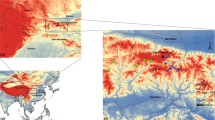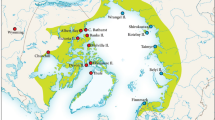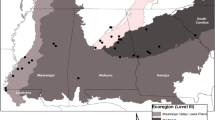Abstract
The fire salamander complex is quite diverse in the Iberian Peninsula where nine subspecies of Salamandra salamandra are currently recognized. Here, we analysed the geographical distribution of the subspecies S. s. gallaica and S. s. crespoi using partial sequences of the mitochondrial cytochrome b gene of 168 individuals from 12 locations in Portugal. Our results support the existence of a deep lineage divergence between the two subspecies, with non-overlapping geographical distributions except in two contact zones: one in Sesimbra on the western coast, and another in Alcoutim on the southeastern border with Spain. Moreover, S. s. crespoi displays signs of gene flow among the sampled locations whereas S. s. gallaica shows evidence of some restriction to gene flow. Present-day genetic make-up of S. s. gallaica and S. s. crespoi is a result of past historical events, fine-tuned by contemporary Iberian geoclimate. Humid mountain areas were found to harbour increased genetic diversity possibly acting as past refugia during drier interglacial periods. To analyse wider geographical patterns and lineage splitting events within S. salamandra we performed a Bayesian dating analysis completing our data set with previously published sequences. The observed divergences were associated to successive biogeographic scenarios, and to other Iberian species showing similar trends.




Similar content being viewed by others
References
Alexandrino J, Froufe E, Arntzen J, Ferrand N (2000) Genetic subdivision, glacial refugia and postglacial recolonization in the golden-striped salamander, Chioglossa lusitanica (Amphibia: Urodela). Mol Ecol 9(6):771–781
Alexandrino J, Ferrand N, Arntzen J (2005) Morphological variation in two genetically distinct groups of the golden-striped salamander, Chioglossa lusitanica (Amphibia: Urodela). Contrib Zool 74:213–222
Almeida N, Almeida P, Gonçalves H, Sequeira F, Teixeira J, Almeida F (2004) Anfíbios e Répteis de Portugal. Guia Fapas—Fundo para a Protecção dos Animais Selvagens, Porto
Altaba CR (1997) Phylogeny and biogeography of midwife toads: a reappraisal. Contrib Zool 66:257–262
Altaba CR (1998) Testing vicariance: melanopsid snails and Neogene tectonics in the Western Mediterranean. J Biogeogr 25:541–551
Bella J, Serrano L, Orellana J, Mason P (2007) The origin of the Chorthippus parallelus hybrid zone: chromosomal evidence of multiple refugia for Iberian populations. J Evol Biol 20(2):568–576
Bolnick DI, Fitzpatrick BM (2007) Sympatric speciation: models and empirical evidence. Annu Rev Ecol Evol Syst 38:459–487
Cachão M, Silva CM (2000) The three main marine depositional cycles of the Neogene of Portugal. Ciências da Terra (UNL) 14:303–312
Calvo J, Daams R, Morales J, López-Martínez N, Agustí J, Anadón P, Armenteros I, Cabrera L, Civis J, Corrochano A (1993) Up-to-date Spanish continental Neogene synthesis and paleoclimatic interpretation. Revista de la Sociedad Geológica de España 6(3–4):29–40
Campillo S, Serra M, Carmona MJ, Gómez A (2011) Widespread secondary contact and new glacial refugia in the halophilic rotifer Brachionus plicatilis in the Iberian Peninsula. PLoS ONE 6(6):e20986
Carrion JS, Yll EI, Walker MJ, Legaz AJ, Chain C, Lopez A (2003) Glacial refugia of temperate, Mediterranean and Ibero North African flora in south eastern Spain: new evidence from cave pollen at two Neanderthal man sites. Glob Ecol Biogeogr 12(2):119–129
Centeno-Cuadros A, Delibes M, Godoy J (2009) Phylogeography of Southern Water Vole (Arvicola sapidus): evidence for refugia within the Iberian glacial refugium? Mol Ecol 18:3652–3667
Charlesworth B, Charlesworth D (1999) The genetic basis of inbreeding depression. Genet Res 74(03):329–340
Cockerham C (1973) Analyses of gene frequencies. Genetics 74(4):679
Cushman S (2006) Effects of habitat loss and fragmentation on amphibians: a review and prospectus. Biol Conserv 128(2):231–240
Deffontaine V, Libois R, Kotlik P, Sommer R, Nieberding C, Paradis E, Searle JB, Michaux JR (2005) Beyond the Mediterranean peninsulas: evidence of central European glacial refugia for a temperate forest mammal species, the bank vole (Clethrionomys glareolus). Mol Ecol 14(6):1727–1739
Drummond A, Rambaut A (2007) BEAST: Bayesian evolutionary analysis by sampling trees. BMC Evol Biol 7(1):214
Drummond A, Ho S, Phillips M, Rambaut A (2006) Relaxed phylogenetics and dating with confidence. PLoS Biol 4(5):699
Drummond AJ, Ashton B, Buxton S, Cheung M, Cooper A, Duran C, Field M, Heled J, Kearse M, Markowitz S, Moir R, Stones-Havas S, Sturrock S, Thierer T, Wilson A (2010) Geneious v5.3. Available from http://www.geneious.com
Dupanloup I, Schneider S, Excoffier L (2002) A simulated annealing approach to define the genetic structure of populations. Mol Ecol 11(12):2571–2581
Excoffier L, Lischer H (2010) Arlequin suite ver 3.5: a new series of programs to perform population genetics analyses under Linux and Windows. Mol Ecol Resour 10(3):564–567
Fauquette S, Suc J, Guiot J, Diniz F, Feddi N, Zheng Z, Bessais E, Drivaliari A (1999) Climate and biomes in the West Mediterranean area during the Pliocene. Palaeogeogr Palaeoclimatol Palaeoecol 152(1–2):15–36
Ferrero M, Blanco-Aguiar J, Lougheed S, Sánchez-Barbudo I, De Nova P, Villafuerte R, Dávila J (2011) Phylogeography and genetic structure of the red-legged partridge (Alectoris rufa): more evidence for refugia within the Iberian glacial refugium. Mol Ecol 20:2628–2642
Fonseca A, Arntzen J, Crespo E, Ferrand N (2003) Regional differentiation in the common midwife toad (Alytes obstetricans) in Portugal: a picture from mitochondrial DNA. Zeitschrift für Feldherpetologie 10:83–89
Francis ETB (1934) The anatomy of the salamander. The Clarendon Press, Oxford, UK
Frankham R (2003) Genetics and conservation biology. C R Biol 326(Supplement 1):22–29
García-Paris M, Alcobendas M, Alberch P (1998) Influence of the Guadalquivir River Basin on mitochondrial DNA evolution of Salamandra salamandra (Caudata: Salamandridae) from Southen Spain. Copeia 1(Feb):173–176
García-París M, Alcobendas M, Buckley D, Wake DB (2003) Dispersal of viviparity across contact zones in Iberian populations of fire salamanders (Salamandra) inferred from discordance of genetic and morphological traits. Evolution 57(1):129–143
Garzón M, Dios R, Ollero H (2007) Predictive modelling of tree species distributions on the Iberian Peninsula during the Last Glacial Maximum and Mid-Holocene. Ecography 30:120–134
Gasser F (1978) Le polytypisme de l’espèce paléarctique Salamandra salamandra (amphibien urodele). II. Systémmatique, relations génétiques et tendances évolutives dans l’aire de rèpatition. Archives de Zoologie Expérimentale et Générale 119:635–668
Gómez A, Lunt DH (2007) Refugia within refugia: patterns of phylogeographic concordance in the Iberian Peninsula. In: Weiss S, Ferrand N (eds) Phylogeography in southern European refugia: evolutionary perspectives on the origins and conservation of European biodiversity. Kluwer, Dordrecht, pp 155–188
Gonçalves H, Martínez-Solano I, Pereira R, Carvalho B, García-París M, Ferrand N (2009) High levels of population subdivision in a morphologically conserved Mediterranean toad (Alytes cisternasii) result from recent, multiple refugia: evidence from mtDNA, microsatellites and nuclear genealogies. Mol Ecol 18(24):5143
Griffiths R (1996) Newts and salamanders of Europe. T & A.D. Poyser, London
Hewitt GM (2004) Genetic consequences of climatic oscillations in the quaternary. Philos Trans R Soc Lond B Biol Sci 359(1442):183–195
Ivanov M (2008) Early Miocene Amphibians (Caudata, Salientia) from the Mokr—Western Quarry (Czech Republic) with comments on the evolution of Early Miocene amphibian assemblages in Central Europe. Geobios 41(4):465–492
Jaarola M, Searle J (2003) A highly divergent mitochondrial DNA lineage of Microtus agrestis in southern Europe. Heredity 92(3):228–234
Joffre R, Rambal S, Ratte J (1999) The dehesa system of southern Spain and Portugal as a natural ecosystem mimic. Agrofor Syst 45(1):57–79
Joger U, Steinfarz S (1994) Zur subspezifischen gliederung der südiberischen feuersalamander (Salamandra salamandra-komplex). Abh ber Naturkde Vorgesch Magdeburg 17:83–98
Johansson M, Primmer C, Merila J (2007) Does habitat fragmentation reduce fitness and adaptability? A case study of the common frog (Rana temporaria). Mol Ecol 16:2693–2700
Knowles LL, Kubatko LS (2010) Estimating species trees: an introduction to concepts and models. In: Knowles LL, Kubatko LS (eds) Estimating species trees: practical and theoretical aspects. Wiley-Blackwell, Hoboken, New Jersey, pp 1–14
Kuchta S, Parks D, Mueller R, Wake D (2009) Closing the ring: historical biogeography of the salamander ring species Ensatina eschscholtzii. J Biogeogr 36(5):982–995. doi:10.1111/j.1365-2699.2008.02052.x
Malkmus R (2004) Amphibians and reptiles of Portugal, Madeira and the Azores-Archipelago. Koeltz Sceintific Books, Germany
Mantel N (1967) The detection of disease clustering and a generalized regression approach. Cancer Res 27:209–220
Martín J, Braga J, Aguirre J, Puga-Bernabéu A (2009) History and evolution of the North-Betic Strait (Prebetic Zone, Betic Cordillera): a narrow, early Tortonian, tidal-dominated, Atlantic-Mediterranean marine passage. Sed Geol 216(3–4):80–90
Martinez-Solano I (2004) Phylogeography of Iberian Discoglossus (Anura: Discoglossidae). J Zool Syst Evol Res 42(4):298–305
Martínez-Solano I, Alcobendas M, Buckley D, García-París M (2005) Molecular characterisation of the endangered Salamandra salamandra almanzoris (Caudata, Salamandridae). Ann Zool Fennici 42:57–68
Martinez-Solano I, Goncalves HA, Arntzen JW, Garcia-Paris M (2004) Phylogenetic relationships and biogeography of midwife toads (Discoglossidae: Alytes). J Biogeogr 31(4):603–618
Martinez-Solano I, Teixeira J, Buckley D, Garcia-Paris M (2006) Mitochondrial DNA phylogeography of Lissotriton boscai (Caudata, Salamandridae): evidence for old, multiple refugia in an Iberian endemic. Mol Ecol 15(11):3375–3388
Moritz C, Schneider CJ, Wake DB (1992) Evolutionary relationships within the Ensatina-Eschscholtzii complex confirm the ring species interpretation. Syst Biol 41(3):273–291
Paleo UF (2010) The dehesa/montado landscape. In: Bélair C, Ichikawa K, Wong BYL, Mulongoy KJ (eds) Sustainable use of biological diversity in socio-ecological production landscapes. Background to the ‘Satoyama Initiative for the benefit of biodiversity and human well-being.’ Secretariat of the Convention on Biological Diversity, pp 149–151
Paulo OS, Duas C, Bruford MW, Jordan WC, Nichols RA (2001) The persistence of Pliocene populations through the Pleistocene climatic cycles: evidence from the phylogeography of an Iberian lizard. Proc R Soc B Biol Sci 268(1476):1625–1630
Polzin T, Daneshmand S (2003) On Steiner trees and minimum spanning trees in hypergraphs. Oper Res Lett 31(1):12–20
Posada D (2008a) Collapse v 1.5, 1.2 edn. http://darwin.uvigo.es/software/collapse.html
Posada D (2008b) jModelTest: phylogenetic model averaging. Mol Biol Evol 25:1253–1256
Pulquério MJF, Nichols RA (2006) Dates from the molecular clock: how wrong can we be? TREE 22(4):180–184
Rebelo R (2002) Biology and comparative ecodemography of Salamandra salamandra (L., 1758) in Portugal. University of Lisbon, Lisbon
Rebelo R (2008) Salamandra salamandra. In: Loureiro A, Ferrand de Almeida N, Carretero MA, Paulo OS (eds) Atlas dos Anfíbios e Répteis de Portugal. Instituto da Conservação da Natureza e da Biodiversidade, Lisboa, pp 96–97
Recuero E, García-París M (2011) Evolutionary history of Lissotriton helveticus: multilocus assessment of ancestral vs. recent colonization of the Iberian Peninsula. Mol Phylogenet Evol 60(1):170–182
Rodríguez-Sánchez F, Hampe A, Jordano P, Arroyo J (2010) Past tree range dynamics in the Iberian Peninsula inferred through phylogeography and palaeodistribution modelling: a review. Rev Palaeobot Palynol 162(3):507–521
Rozas J, Sánchez-DelBarrio JC, Messeguer X, Rozas R (2003) DnaSP, DNA polymorphism analysis by the coalescent and other methods. Bioinformatics 19:2496–2497
Saitou N, Nei M (1987) The neighbor-joining method: a new method for reconstructing phylogenies. Mol Biol Evol 4:406–425
Salicru M, Menendez ML, Morales D, Pardo L (1993) Asymptotic distribution of (h, φ)-entropies. Commun Stat Theory Methods 22(7):2015–2031. doi:10.1080/03610929308831131
Sambrook J, Russell DW (2001) Molecular cloning: a laboratory manual. CSHL Press, Cold Spring Harbor, NY, USA
Schmitt T, Hewitt G, Muller P (2006) Disjunct distributions during glacial and interglacial periods in mountain butterflies: Erebia epiphron as an example. J Evol Biol 19(1):108–113
Seddon JM, Santucci F, Reeve NJ, Hewitt GM (2001) DNA footprints of European hedgehogs, Erinaceus europaeus and E. concolor: Pleistocene refugia, postglacial expansion and colonization routes. Mol Ecol 10(9):2187–2198
Sillero N, Brito J, Skidmore A, Toxopeus A (2009) Biogeographical patterns derived from remote sensing variables: the amphibians and reptiles of the Iberian Peninsula. Amphib-Reptilia 30:185–206
Staub N, Brown C, Wake D (1995) Patterns of growth and movements in a population of Ensatina eschscholtzii platensis (Caudata: Plethodontidae) in the Sierra Nevada, California. J Herpetol 29(4):593–599
Steinfartz S, Veith M, Tautz D (2000) Mitochodrial sequence analysis of Salamandra taxa suggests old splits of major lineages and postglacial recolonization of Central Europe from distinct source populations of Salamandra salamandra. Mol Ecol 9:397–410
Surova D, Pinto-correia T (2008) Landscape preferences in the cork oak Montado region of Alentejo, southern Portugal: searching for valuable landscape characteristics for different user groups. Landsc Res 33(3):311–330
Teixeira J (2007) Biogeografia, evolução e conservação da herpetofauna endémica do noroestes da Península Iberica. Oporto University, Oporto, Portugal
Tollefsrud M, Sønstebø J, Brochmann C, Johnsen Ø, Skrøppa T, Vendramin G (2009) Combined analysis of nuclear and mitochondrial markers provide new insight into the genetic structure of North European Picea abies. Heredity 102(6):549–562
Van Andel TH, Tzedakis PC (1996) Palaeolithic landscapes of Europe and environs, 150,000–25,000 years ago: an overview. Quat Sci Rev 15(5–6):481–500
Veith M (1994) Morphological, molecular and life history variation in Salamandra salamandra. Mertensiella 4:355–397
Veith M, Mayer C, Samraoui B, Barroso DD, Bogaerts S (2004) From Europe to Africa and vice versa: evidence for multiple intercontinental dispersal in ribbed salamanders (Genus Pleurodeles). J Biogeogr 31(1):159–171
Veith M, Fromhage L, Kosuch J, Vences M (2006) Historical biogeography of Western Palaearctic pelobatid and pelodytid frogs: a molecular phylogenetic perspective. Contrib Zool 75:109–120
Vicente M, Alés RF (2006) Long term persistence of dehesas. Evidences from history. Agrofor Syst 67(1):19–28
Wilson E, Brown W (1953) The subspecies concept and its taxonomic application. Syst Zool 2(3):97–111
Yule G (1925) A mathematical theory of evolution, based on the conclusions of Dr. JC Willis, FRS. Philos Trans Roy Soc Lond B Biol Sci 213:21–87
Acknowledgments
We are grateful to Sofia Caetano and Pedro Beja for an early conceptual and practical contribution to this work. Marta Valente provided the sequencing service. We thank Vítor Almada, and two anonymous referees for helpful comments on an early version of the manuscript and a third referee for a valuable comment on the last version. This work was supported by funding from the Portuguese National Science Foundation (Fundação para a Ciência e a Tecnologia—Portugal) to CCMAR (plurianual funding).
Author information
Authors and Affiliations
Corresponding author
Additional information
Davide M. Reis and Rita Castilho contributed equally to the work.
An erratum to this article can be found at http://dx.doi.org/10.1007/s10709-011-9612-y
Rights and permissions
About this article
Cite this article
Reis, D.M., Cunha, R.L., Patrão, C. et al. Salamandra salamandra (Amphibia: Caudata: Salamandridae) in Portugal: not all black and yellow. Genetica 139, 1095–1105 (2011). https://doi.org/10.1007/s10709-011-9609-6
Received:
Accepted:
Published:
Issue Date:
DOI: https://doi.org/10.1007/s10709-011-9609-6




